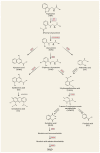Exploring the Tryptophan Metabolic Pathways in Migraine-Related Mechanisms
- PMID: 36497053
- PMCID: PMC9736455
- DOI: 10.3390/cells11233795
Exploring the Tryptophan Metabolic Pathways in Migraine-Related Mechanisms
Abstract
Migraine is a complex neurovascular disorder, which causes intense socioeconomic problems worldwide. The pathophysiology of disease is enigmatic; accordingly, therapy is not sufficient. In recent years, migraine research focused on tryptophan, which is metabolized via two main pathways, the serotonin and kynurenine pathways, both of which produce neuroactive molecules that influence pain processing and stress response by disturbing neural and brain hypersensitivity and by interacting with molecules that control vascular and inflammatory actions. Serotonin has a role in trigeminal pain processing, and melatonin, which is another product of this pathway, also has a role in these processes. One of the end products of the kynurenine pathway is kynurenic acid (KYNA), which can decrease the overexpression of migraine-related neuropeptides in experimental conditions. However, the ability of KYNA to cross the blood-brain barrier is minimal, necessitating the development of synthetic analogs with potentially better pharmacokinetic properties to exploit its therapeutic potential. This review summarizes the main translational and clinical findings on tryptophan metabolism and certain neuropeptides, as well as therapeutic options that may be useful in the prevention and treatment of migraine.
Keywords: CGRP; PACAP; kynurenic acid; kynurenic pathway; melatonin; migraine; primary headaches; serotonin; serotonin pathway; tryptophan.
Conflict of interest statement
The authors declare no conflict of interest.
Figures






Similar articles
-
[New perspectives in the treatment of migraine: the role of the kynurenine pathway in the pathophysiology of migraine].Orv Hetil. 2025 Jun 8;166(23):879-886. doi: 10.1556/650.2025.33327. Print 2025 Jun 8. Orv Hetil. 2025. PMID: 40483687 Review. Hungarian.
-
The L-kynurenine signalling pathway in trigeminal pain processing: a potential therapeutic target in migraine?Cephalalgia. 2011 Jul;31(9):1029-38. doi: 10.1177/0333102411404717. Epub 2011 May 18. Cephalalgia. 2011. PMID: 21593189 Review.
-
Altered kynurenine pathway metabolites in serum of chronic migraine patients.J Headache Pain. 2015;17:47. doi: 10.1186/s10194-016-0638-5. Epub 2016 Apr 29. J Headache Pain. 2015. PMID: 27130315 Free PMC article.
-
Regulating the balance between the kynurenine and serotonin pathways of tryptophan metabolism.FEBS J. 2017 Mar;284(6):948-966. doi: 10.1111/febs.14026. Epub 2017 Feb 20. FEBS J. 2017. PMID: 28118532
-
Neurotransmitter and tryptophan metabolite concentration changes in the complete Freund's adjuvant model of orofacial pain.J Headache Pain. 2020 Apr 21;21(1):35. doi: 10.1186/s10194-020-01105-6. J Headache Pain. 2020. PMID: 32316909 Free PMC article.
Cited by
-
Exploring the Interaction of Indole-3-Acetonitrile with Neuroblastoma Cells: Understanding the Connection with the Serotonin and Dopamine Pathways.Biomedicines. 2023 Dec 16;11(12):3325. doi: 10.3390/biomedicines11123325. Biomedicines. 2023. PMID: 38137546 Free PMC article.
-
Exploring the Association Between Human Blood Metabolites and Autism Spectrum Disorder Risk: A Bidirectional Mendelian Randomization Study.Health Sci Rep. 2025 Mar 3;8(3):e70528. doi: 10.1002/hsr2.70528. eCollection 2025 Mar. Health Sci Rep. 2025. PMID: 40041792 Free PMC article.
-
Exploring Novel Therapeutic Targets in the Common Pathogenic Factors in Migraine and Neuropathic Pain.Int J Mol Sci. 2023 Feb 18;24(4):4114. doi: 10.3390/ijms24044114. Int J Mol Sci. 2023. PMID: 36835524 Free PMC article. Review.
-
Pediatric hypnic headache: a systematic review.Front Neurol. 2023 Aug 11;14:1254567. doi: 10.3389/fneur.2023.1254567. eCollection 2023. Front Neurol. 2023. PMID: 37638182 Free PMC article.
-
Oxidative imbalance as a co-player in jaw functional limitations and biopsychosocial profile in patients with temporomandibular disorder-myofascial pain with referral.Front Neurol. 2025 Jan 3;15:1509845. doi: 10.3389/fneur.2024.1509845. eCollection 2024. Front Neurol. 2025. PMID: 39830201 Free PMC article.
References
-
- Cerbo R., Pesare M., Aurilia C., Rondelli V., Barbanti P. Socio–economic costs of migraine. J. Headache Pain. 2001;2((Suppl. S1)):s15–s19. doi: 10.1007/s101940170003. - DOI
Publication types
MeSH terms
Substances
Grants and funding
LinkOut - more resources
Full Text Sources
Medical
Research Materials

